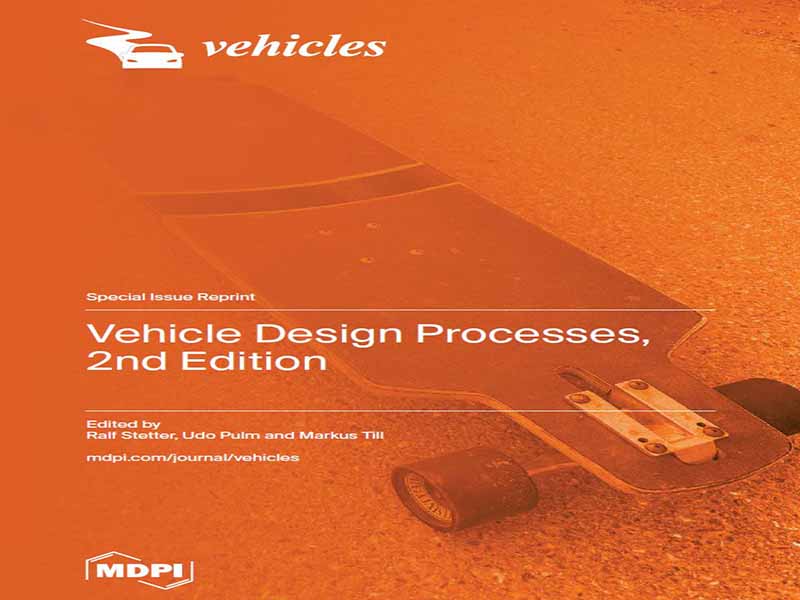- عنوان کتاب: Vehicle Design Processes, Second Edition
- نویسنده/انتشارات: Ralf Stetter, Udo Pulm, Markus Till
- حوزه: طراحی خودرو
- سال انتشار: 2025
- تعداد صفحه: 280
- زبان اصلی: انگلیسی
- نوع فایل: pdf
- حجم فایل: 7.71 مگابایت
این شماره ویژه، وضعیت فعلی تحقیقات در مورد فرآیندهای طراحی خودرو را گزارش میدهد. طراحی خودرو به دلایل مختلف یکی از چالشبرانگیزترین وظایف در مهندسی است. انتظارات قابل توجه مصرفکننده و رقابت شدید جهانی، طراحی خودرو را پیچیده میکند. در حال حاضر، تغییرات چشمگیری بر طراحی خودرو تأثیر میگذارند که عمدتاً ناشی از گذار به سیستمهای محرک الکتریکی و سناریوهای جدید کاربرد خودرو، به ویژه در بازار آسیا است. طراحی مبتنی بر هزینه یک ضرورت است و خودروها باید از نظر تولید، بهرهبرداری و بازیافت اقتصادی باشند. طراحی پایدار نیز برای دستیابی به خودروهای اکولوژیکی ضروری است. پویایی خودروها باید در طراحی همه اجزا در نظر گرفته شود و طراحی سبک وزن از اهمیت اساسی برخوردار است. مصرفکنندگان انتظار عملکرد عملکردی قانعکننده، کیفیت بالای محصول، ظاهری جذاب، قابلیت اطمینان بالا، عملکرد به هم پیوسته و رابطهای کاربری قابل فهم و جذاب را دارند. انتظار میرود خودروها خدمات اضافی بیشتری، همچنین در ارتباط با ارائه دهندگان خدمات خارجی، ارائه دهند. این الزامات عظیم منجر به فرآیندهای پیچیده طراحی چند دامنهای خودرو میشود زیرا بیشتر تصمیمات مهم در مرحله طراحی گرفته میشود. بهینهسازی تولید و عملکرد هوشمند موضوعات مهمی هستند، اما نقصها و نارساییها در مرحله طراحی منجر به هزینههای قابل توجه در مراحل بعدی و محصولات غیربهینه میشود. فرآیندهای طراحی وسایل نقلیه شامل هزاران مهندس است که در سراسر جهان پراکنده شدهاند و نیاز به بررسی نسخهها و انواع مختلف محصول و همچنین پلتفرمهای محصول چند شرکتی دارند. الزامات آزمایش و مسائل حقوقی اغلب نقش مهمی در این فرآیندها ایفا میکنند و کیفیت اقتصادی و زیستمحیطی یک محصول باید در طول این فرآیندها مورد نظارت قرار گیرد. ایمنی و کیفیت ارگونومیک وسیله نقلیه حتی در مراحل اولیه نیز باید در نظر گرفته شود. طبیعتاً، تنها پشتیبانی دیجیتال این فرآیندها را امکانپذیر میکند. برای همه حوزهها، ابزارهای کامپیوتری قدرتمندی برای سنتز، تجزیه و تحلیل، ارزیابی و بهینهسازی ایجاد شده است و تلاشهای متعددی برای پیوند معقول دادههای مورد استفاده در همه این ابزارها انجام شده است. با این حال، کثرت قالبهای داده خاص و عمومی حوزه و حجم عظیم دادهها هنوز هم مشکلات جدی ایجاد میکند. نکته مهم این است که طراحی همچنین با برنامهریزی و مدیریت پروژه مرتبط است زیرا تصمیمات خاص طراحی میتواند منجر به فرآیندهای طولانی مدت آزمایش و آمادهسازی تولید شود. در سالهای اخیر، تیمهای تحقیقاتی در سراسر جهان رویکردهای جدید، توسعهیافته و بهبود یافتهای را پیشنهاد کردهاند که ممکن است فرآیندهای طراحی خودرو را پشتیبانی، تقویت و سادهسازی کنند. رویکردهای امیدوارکننده بر سطوح انتزاعی مدلسازی محصول – به ویژه سطح عملکرد [1] و سطح فیزیک انتزاعی [2] – تمرکز دارند. شرکتهای پیشرو در زمینه توسعه و تولید خودرو، از مدیریت فرآیند مبتنی بر سند به مهندسی سیستمهای مبتنی بر مدل (MBSE) روی آوردهاند و چندین گروه تحقیقاتی در این گذار نقش داشتهاند [3-5]. یک زمینه علمی محوری در این زمینه، اتوماسیون فرآیندهای طراحی است. زبانهای طراحی مبتنی بر نمودار (GBDLs) نمونه مهمی هستند. آنها منجر به تغییر الگو در فرآیندهای طراحی شدهاند و امکان ادغام دادهها، اطلاعات و دانش را در مدلهای محصول و سیستمها فراهم میکنند و اتوماسیون طراحی را تقویت میکنند [6-8]. یکی دیگر از زمینههای علمی محوری، بر گسترش دستورالعملهای طراحی برای X تأکید دارد. نمونههای مهم عبارتند از طراحی مقاوم در برابر خطا (FTD) [9]، طراحی برای پایداری [10] و طراحی برای انعطافپذیری [11]. یکی دیگر از زمینههای امیدوارکننده، ادغام قابلیتهای کنترل و تشخیص در اجزای خودرو است که بر عملکرد روانتر و کارآمدتر و افزایش تحمل خطا تمرکز دارد [12]. چندین گروه تحقیقاتی بر ایجاد یک دوقلوی دیجیتال کامل از یک وسیله نقلیه تمرکز کردهاند که امکان تعامل دو طرفه را در زمان واقعی فراهم میکند و تمام مراحل چرخه عمر یک وسیله نقلیه را پوشش میدهد [13]. مجموعه دیگری از رویکردها، ادغام هوش مصنوعی (AI) را در فرآیندهای طراحی، مونتاژ و تولید هدف قرار میدهد [14،15]. چالشهای ذکر شده و کثرت رویکردهای مربوط به فرآیندهای طراحی چند دامنهای وسایل نقلیه، منجر به نیاز مبرم به تحقیقات با هدف حمایت از مهندسان طراح در این تلاش شده است. این شماره ویژه، مجموعهای از تحقیقات در این زمینه را ارائه میدهد.
This Special Issue reports on the current status of research concerning vehicle design processes. Designing vehicles is one of the most challenging tasks in engineering for several reasons. Considerable consumer expectations and intense global competition complicate vehicle design. Currently, dramatic changes are influencing vehicle design, mainly caused by the transition to electric drive systems and new vehicle application scenarios, especially in the Asian market. Cost-driven design is a necessity, and vehicles must be economical in terms of production, operation, and recycling. Sustainable design is also imperative in order to achieve ecological vehicles. The dynamics of vehicles must be considered in the design of all components, and lightweight design is of fundamental importance. Consumers expect convincing functional performance, high product quality, an appealing appearance, high reliability, interconnected functionality, and comprehensible and appealing user interfaces. Vehicles are expected to provide more and more additional services, also in connection with external service providers. These colossal requirements lead to complex multi-domain vehicle design processes because most of the important decisions are made in the design phase. Production optimization and intelligent operation are important topics, but flaws and insufficiencies in the design stage lead to considerable expenditure in later stages and suboptimal products. The design processes of vehicles involve thousands of engineers, who are spread out across the globe and need to consider multiple product versions and variants as well as multi-company product platforms. Testing necessities and legal issues frequently play an important role in these processes, and the economic and ecological quality of a product must be monitored throughout these processes. Vehicle safety and ergonomic quality must be considered even in the early stages. Naturally, only digital support makes these processes feasible. For all domains, powerful computer tools for synthesis, analysis, evaluation, and optimization have been created, and numerous attempts have been made to sensibly link the data used in all these tools. However, the multitude of domain-specific and generic data formats and the sheer size of the data still cause serious problems. Importantly, design is also connected with scheduling and project management because certain design decisions can lead to long-term testing and production preparation processes. In recent years, research teams worldwide have proposed novel, expanded, and improved approaches, which may support, enhance, and streamline vehicle design processes. The promising approaches concentrate on the abstract levels of product modelling—especially the function level [1] and the level of abstract physics [2]. Leading companies in the field of vehicle development and production have made a shift from document-based process management to model-based systems engineering (MBSE), and several research groups have contributed to this transition [3–5]. A central scientific field in this context is the automation of design processes. Graph-based design languages (GBDLs) constitute an important example; they have led to a paradigm shift in design processes, enabling the integration of data, information, and knowledge into product and systems models and fostering design automation [6–8]. Another central scientific field emphasizes the expansion of the established design-for-X guidelines. Important examples are fault-tolerant design (FTD) [9], design for sustainability [10], and design for resilience [11]. Another promising field is the integration of control and diagnosis capabilities in vehicle components, focusing on smoother, more efficient operation and increased fault tolerance [12]. Several research groups have focused on the establishment of a full-scope digital twin of a vehicle that allows bi-directional interaction in real time and covers all the life-cycle stages of a vehicle [13]. Another set of approaches aims at the integration of artificial intelligence (AI) in design, assembly, and production processes [14,15]. The listed challenges and the multitude of approaches concerning the multi-domain design processes of vehicles have led to a prominent need for research aimed at supporting design engineers in this endeavor. This Special Issue presents a collection of research in this area.
این کتاب را میتوانید از لینک زیر بصورت رایگان دانلود کنید:
Download: Vehicle Design Processes, Second Edition




































نظرات کاربران